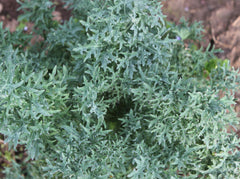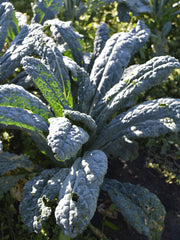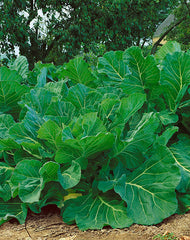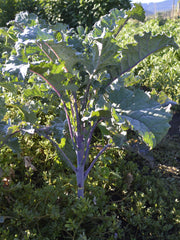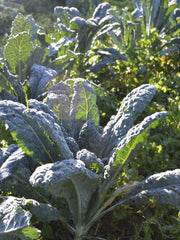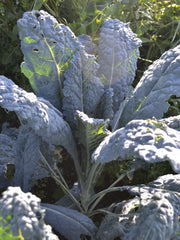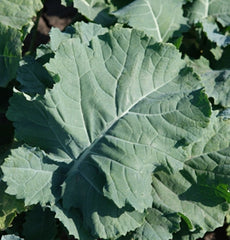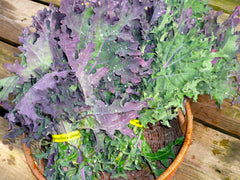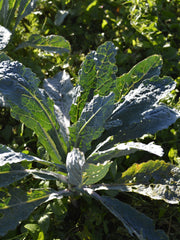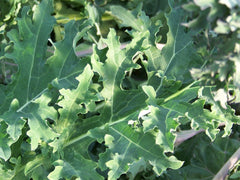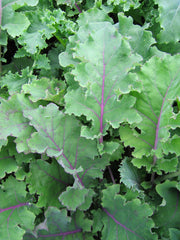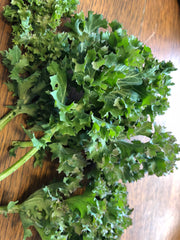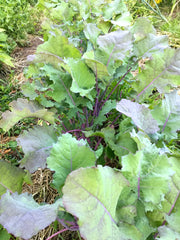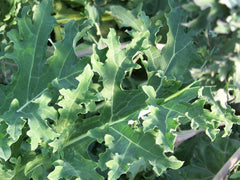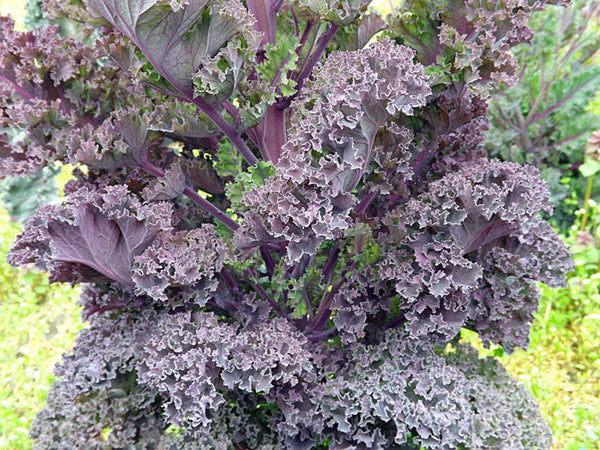Red Winter
Brassica oleracea capitata
HOW TO GROW KALE
Start indoors 4-6 weeks before last frost, plant out 4 weeks before last frost. For fall harvest, transplant 13 weeks before first frost, without additional protection. In a hoophouse, you can plant 2-3 weeks later. Direct seed every 8” in May. Will over winter in zone 7b, becomes sweeter with frost. Harvest from the bottom of the stem up with a quick snap down at the base of the leaves. Dunk in cold water to wash, store at 32˚F.15. Row covers reduce cabbage worms and extend winter harvest. Leaves are frost hardy to about 25–22˚F. Soil pH 6.1-6.5. Hardiness zones 3-9. Biennial.
Days from maturity calculated from the date of seeding. Average 7,000 seeds per ounce. Average 112M seeds per acre. Federal germination standard: 75%. Usual seed life: 4 years. Isolation distance for seed saving: 1 mile.
Planting Depth 1/4”
Soil Temp. Germ. 55-75˚F
Days to Germ. 5-10
Plant Spacing 12-18”
Row Spacing 24”
Days To Maturity 62
Full Sun, Moist Well Drained
Days from maturity calculated from the date of seeding. Average 7,000 seeds per ounce. Average 112M seeds per acre. Federal germination standard: 75%. Usual seed life: 4 years. Isolation distance for seed saving: 1 mile.
Planting Depth 1/4”
Soil Temp. Germ. 55-75˚F
Days to Germ. 5-10
Plant Spacing 12-18”
Row Spacing 24”
Days To Maturity 62
Full Sun, Moist Well Drained
Red Winter Seed Count
1 Ounce ≈ 14,175 seeds
- 200 Seeds$4.10
- 2000 Seeds$12.50
- 1 Ounce$26.00
Developed on Nash’s farm, it is our main production winter kale for its cold-hardiness, red/purple color, frilly leaves and 4-foot stature. Has powdery mildew resistance and reliable survivability down to temperatures in the teens (°F). Provides consistent leaf production through the winter. Plant in June for good p...
Developed on Nash’s farm, it is our main production winter kale for its cold-hardiness, red/purple color, frilly leaves and 4-foot stature. Has powdery mildew resistance and reliable survivability down to temperatures in the teens (°F). Provides consistent leaf production through the winter. Plant in June for good plant structure going into winter.
The Origin of Nash’s Red Kale
Farmers have been developing new crop varieties for thousands of years. Back in 1990, Nash planted 3 acres of a kale variety called Vates, a green kale with frilly leaves. He noticed 2 bright purple plants in the middle of the sea of green. They were “sports,” or plants that had randomly mutated on their own. Realizing he could encourage this purple color, Nash dug up the 2 plants and isolated them in his home garden. He surrounded them with 10 Brussels sprouts plants so they would pollinate each other, because he also wanted eventually to achieve a kale plant with the height of the Brussels sprouts and with leaves that could be harvested from lower to upper levels as the plant grew. This would make it easier to harvest, and the farm could get several bunches of kale per plant, making it more profitable. “That was a lot to ask,” Nash says. “But I thought I may as well go for it!”
Some of the offspring of the kale sport/Brussels sprout cross showed these characteristics. But it took many seasons of planting and cross-pollinating, before Nash and his team were able to consistently get kale with the desired traits. However, about 5% of the plants continued to be green instead of purple. With the help of Dr. John Navazio of Organic Seed Alliance in Port Townsend, they were able to greatly reduce the number of plants manifesting the green color. This year, 2014, the farm was finally able to sell seed to other farmers, relatively confident that they would get the crop they were expecting.
Nash’s Red Kale also has a bonus benefit—cold-hardiness. It can reliably survive in temperatures down into the teens and has become a mainstay winter kale.
This is NOT “genetic modification” as in GMOs created by Monsanto. Nash only influenced how those original sports were pollinated. He did not forcibly inject the genetic material from one completely different species into another in a laboratory as biotech companies do. He used the classical seed breeding methods that farmers have safely used throughout the history of agriculture. Tags: Type: European, Color: Red, Specialty: Cool Climate, Specialty: Disease Resistant, Season: Spring Fall Winter, Certification: Organic.
The Origin of Nash’s Red Kale
Farmers have been developing new crop varieties for thousands of years. Back in 1990, Nash planted 3 acres of a kale variety called Vates, a green kale with frilly leaves. He noticed 2 bright purple plants in the middle of the sea of green. They were “sports,” or plants that had randomly mutated on their own. Realizing he could encourage this purple color, Nash dug up the 2 plants and isolated them in his home garden. He surrounded them with 10 Brussels sprouts plants so they would pollinate each other, because he also wanted eventually to achieve a kale plant with the height of the Brussels sprouts and with leaves that could be harvested from lower to upper levels as the plant grew. This would make it easier to harvest, and the farm could get several bunches of kale per plant, making it more profitable. “That was a lot to ask,” Nash says. “But I thought I may as well go for it!”
Some of the offspring of the kale sport/Brussels sprout cross showed these characteristics. But it took many seasons of planting and cross-pollinating, before Nash and his team were able to consistently get kale with the desired traits. However, about 5% of the plants continued to be green instead of purple. With the help of Dr. John Navazio of Organic Seed Alliance in Port Townsend, they were able to greatly reduce the number of plants manifesting the green color. This year, 2014, the farm was finally able to sell seed to other farmers, relatively confident that they would get the crop they were expecting.
Nash’s Red Kale also has a bonus benefit—cold-hardiness. It can reliably survive in temperatures down into the teens and has become a mainstay winter kale.
This is NOT “genetic modification” as in GMOs created by Monsanto. Nash only influenced how those original sports were pollinated. He did not forcibly inject the genetic material from one completely different species into another in a laboratory as biotech companies do. He used the classical seed breeding methods that farmers have safely used throughout the history of agriculture. Tags: Type: European, Color: Red, Specialty: Cool Climate, Specialty: Disease Resistant, Season: Spring Fall Winter, Certification: Organic.
Learn More
Meet Your Farmer
We promote fair trade, organic practices and environmental responsibility throughout the Restoration Seeds supply chain. Below are the family farmers and seed suppliers who bring our open pollinated seeds to you.
Nash’s Organic Produce
Certified Organic by WA Dept. of Ag.
Seed grower since 1979


Preserving seed is a skill every organic farmer must have, and Nash has been doing it for years. He routinely saves carrot, cabbage, kale and spinach seeds, along with all of the grains. The team at Nash’s is farming about 450 acres: 75 acres of vegetables, berries and orchard; 150 acres of grain; 20 acres of organic seed; 50 acres devoted to pigs, poultry, and compost; and the rest is fallow or in hay. The farm employs about 25 people year ‘round and 40 at the peak of the season, making the it one of the larger private-sector employers in Sequim; and sells at 7 local farmers markets and wholesale."
Reviews
